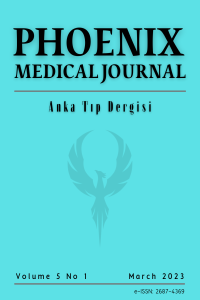Anestezistler İçin Radyasyon Güvenliği
Radiation Safety for Anesthesiologists
radiation, safety, anethesiology,
___
- Berrington A, Darby SC, Weiss HA, Doll R. 100 years of observation on British radiologists: mortality from cancer and other causes 1897–1997. Br J Radiol. 2001;74(882):507–519.
- Cancer risk from professional exposure in staff working in cardiac catheterization laboratory: insights from the National Research Council’s Biological Effects of Ionizing Radiation VII Report. Am Heart J. 2009;157(1):118–124.
- Domienik J, Brodecki M, Carinou E, Donadille L, Jankowski J, Koukorava C, et al. Extremity and eye lens doses in interventional radiology and cardiology procedures: first results of the ORAMED project. Radiat Prot Dosimetry. 2011;144:442–447.
- T.Pırnar, O.Dicle. Radiation Oncology A.Century of Progress and Achievement, published by ESTRO, 1995
- Jansen A. Radiation dose and risk, Radiation Protection 136; European guidelines on radiation protection in dental radiology. The safe use of radiographs in dental practice Luxembourg: Office for Official Publications of the European Communities. 2004. pp 11-17.
- Wrixon AD. New ICRP recommendations. J Radiol Prot. 2008;28:161–168.
- ICRP. The 2007 recommendations of the International Commission on Radiological Protection. Ann ICRP. 2007;103:1–332.
- Pierce DA, Shimizu Y, Preston DL, Vaeth M, Mabuchi K. Studies of the mortality of atomic bomb survivors. Report 12, Part I. Cancer: 1950–1990. Radiat Res. 1996;146(1):1–27.
- Cardis E, Vrijheid M, Blettner M, Gilbert E, Hakama M, Hill C, et al. The 15-Country Collaborative Study of Cancer Risk among Radiation Workers in the Nuclear Industry: estimates of radiation- related cancer risks. Radiat Res. 2007;167(4):396–416.
- Bashore TM, Bates ER, Berger PB, Clark DA, Cusma JT, Dehmer GJ, et al. American College of Cardiology/ Society for Cardiac Angiography and Interventions Clinical Expert Consensus Document on cardiac catheterization laboratory standards. A report of the American College of Cardiology Task Force on Clinical Expert Consensus Documents. J Am Coll Cardiol. 2001;37(8):2170–2214.
- Semelka RC, Armao DM, Elias J Jr, Huda W. Imaging strategies to reduce the risk of radiation in CT studies, including selective substitution with MRI. J Magn Reson Imaging. 2007;25(5):900–909.
- Steven B, Elwin R, Tilson Ed. Practical Radiation Protection and Applied Radiobiology, 2e 2nd Edition. Saunders, 1999.
- Mitelman F, Johansson B, Mertens F. Mitelman database of chromosome aberrations and gene fusions in cancer. 2010 [updated 2010; cited 07 February 2011].
- National Academy of Sciences/National Research Council (NAS/NRC), Health Risks from Exposure to Low Levels of Ionizing Radiation:BEIR VII Phase 2, Washington, DC2006.
- Anastasian ZH, Strozyk D, Meyers PM, Wang S, Berman MF. Radiation exposure of the anesthesiologist in the neurointerventional suite. Anesthesiology. 2011;114(3):512-20.
- Williams PM, Fletcher S. Health effects of prenatal radiation exposure. Am Fam Physician. 2010;82(5):488–493.
- Wakeford R, Little MP. Risk coefficients for childhood cancer after intrauterine irradiation: a review. Int J Radiat Biol. 2003;79(5):293–309.
- Vano E, Gonzalez L, Fernandez JM, Haskal ZJ. Eye lens exposure to radiation in interventional suites: caution is warranted. Radiology. 2008;248(3):945–953.
- Klein LW, Miller DL, Balter S, Laskey W, Haines D, Norbash A, et al. Occupational health hazards in the interventional laboratory: time for a safer environment. J Vasc Interv Radiol. 2009;20(2):147–152.
- Cousin AJ, Lawdahl RB, Chakraborty DP, Koehler RE. The case for radioprotective eyewear/facewear. Practical implications and suggestions. Invest Radiol. 1987;22(8):688–692.
- ICRP. Radiologial protection education and training for healthcare staff and students. 2010 [cited 19 February 2011]. http://www.icrp.org/docs/ICRP_ Report- RP_Education_and_Training_for_Healthcare_Staff_and_Students (for_Consultation).pdf.
- Yayın Aralığı: Yılda 3 Sayı
- Başlangıç: 2019
- Yayıncı: İbrahim İKİZCELİ
Pons Lezyonlarının İki Nadir Prezentasyonu: Bir Buçuk Ve Sekiz Buçuk Sendromu
Turgay DÖLEK, Ayşe Özlem AKGÜN, Vedat Semai BEK, Gülnihal KUTLU
Çörek Otu Yağının Bilimsel ve Sağlıklı Yaşam Üzerine Tıbbi ve Terapötik Etkileri
Mohamad EL DHAYBİ, Deniz MESUTOĞLU, Dilara Rana BİÇER
Kardiyopulmoner Resüsitasyon Eğitimine Etki Eden Faktörler: Sakarya Örneği
Nuray ASLAN, Necip Gökhan GUNER, Yeşim DURGUN, Ensar DURMUŞ, Yusuf YURUMEZ
Anestezistler İçin Radyasyon Güvenliği
Ayla ESİN, Yasemin ÖZŞAHİN, Kerem ERKALP, Ziya SALİHOĞLU
Hyoid Kemik Büyük Boynuz Kırığı
Gökhan İŞAT, İbrahim ALTUNOK, Serdar ÖZDEMİR
Toraks Travmalı Olgularda Travma Mekanizmasının Vertebra Fraktürü Eşlik Etme Sıklığına Etkisi
Beliz ÖZTOK TEKTEN, Osman YAKŞİ
Acil Serviste SII ve SIRI değerlerinin CO Zehirlenmesinin Şiddetini Tahmin Etmedeki Rolü
Delici – Kesici Alet Yaralanmalarının Demografik Özellikleri
Ali ŞAHİN, Eren USUL, Yıldız YILDIRIMER, Emrah ARI, Ali HALICI, Engin Deniz ARSLAN
Melike TELLİOĞLU, Muammer YILMAZ, İnci ARIKAN, Yaşar ÇAKMAKÇI
Barış ÇİL, İbrahim DEMİR, Mehmet KABAK, İclal HOCANLI, Mahsuk TAYLAN, Mustafa FİDANTEN
